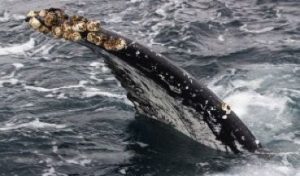Have you ever noticed any strange relationships between different marine animals and wondered how those relationships came to be or what exactly is going on? How about all those barnacles you find on whales? What are they doing there? Were you ever curious as to why Nemo and his father, Marlin, decided to live in an anemone that would sting them? Well those are both what we call symbiotic relationships where marine animals interact with another in beneficial, neutral, or even negative ways to stay ahead of the competition around them!
Symbiosis is a term that describes close, long-term interaction between two different species and it stems from something called competition between individuals or populations. Competition can be increased by limited resources (food, shelter, etc.) or by increases in population size. If competition increases, the death rate of organism increases, individual grow at a slower rate, and reproduction decreases. These effects of high competition can cause species to turn to 1 of 3 different symbiotic relationships for survival. They are called mutualism, commensalism, and parasitism.
 In the famous Disney movie Finding Nemo, Nemo and his father, Marlin, live in a sea anemone. This is, in fact, a great example of mutualistic symbiosis where both species benefit from the relationship! How, you ask, would a clownfish benefit from an an…amen…nen…nem…anom…ne? Habitat of course! A clownfish lives among the poisonous arms of the anemone and receives protection. It will also get the leftovers of the anemone’s meals! Unfortunately the clownfish will not act as a clown for the anemone, but it will act as a housekeeper, bodyguard, and chef. It removes harmful parasites from the anemone, scares away predators, and provides nutrients through its excrement. Another great example is that of the cleaner shrimp and the eel. The eel will open its mouth and allow the cleaner shrimp to clean out harmful parasites that may have found their way in. It may look like the eel would eat the cleaner shrimp, but it is perfectly safe.
In the famous Disney movie Finding Nemo, Nemo and his father, Marlin, live in a sea anemone. This is, in fact, a great example of mutualistic symbiosis where both species benefit from the relationship! How, you ask, would a clownfish benefit from an an…amen…nen…nem…anom…ne? Habitat of course! A clownfish lives among the poisonous arms of the anemone and receives protection. It will also get the leftovers of the anemone’s meals! Unfortunately the clownfish will not act as a clown for the anemone, but it will act as a housekeeper, bodyguard, and chef. It removes harmful parasites from the anemone, scares away predators, and provides nutrients through its excrement. Another great example is that of the cleaner shrimp and the eel. The eel will open its mouth and allow the cleaner shrimp to clean out harmful parasites that may have found their way in. It may look like the eel would eat the cleaner shrimp, but it is perfectly safe.
 Another type of symbiotic relationship is called commensalism. This occurs when one of the species benefits while the other neither benefits nor is hurt. We actually mentioned a perfect example of commensalism earlier with the whale and the barnacle. Barnacles are what we call filter feeders. They filter water in order to pull food out of it. If they ride on whales, they are able to spend less energy while filtering more water and eating more food, but they neither hurt nor benefit the whale.
Another type of symbiotic relationship is called commensalism. This occurs when one of the species benefits while the other neither benefits nor is hurt. We actually mentioned a perfect example of commensalism earlier with the whale and the barnacle. Barnacles are what we call filter feeders. They filter water in order to pull food out of it. If they ride on whales, they are able to spend less energy while filtering more water and eating more food, but they neither hurt nor benefit the whale.
 Our last relationship is parasitic symbiosis; when one species benefits while the other is affected in a negative way. This can be seen when isopods enter the mouths of other fish. They will first eat the tongue of the fish and then have the ability to take the first bite of everything the fish consumes.
Our last relationship is parasitic symbiosis; when one species benefits while the other is affected in a negative way. This can be seen when isopods enter the mouths of other fish. They will first eat the tongue of the fish and then have the ability to take the first bite of everything the fish consumes.
Symbiosis can come in quite a few different forms and is used by an even bigger number of species. It allows animals to work together to overcome competition or to even take advantage of other species. Regardless of the pros or cons of these relationships, they are still part of the coolest and most beautiful aspects of our oceans!
http://marinebio.org/oceans/symbionts-parasites/


